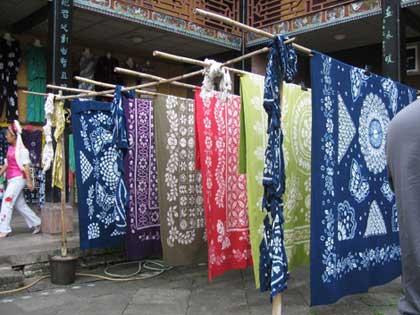Posted 2020/3/15

Embroidery and dyeing skill, known as "skein tie" in the ancient time, is a kind of old textile dyeing workmanship in China which is named knot cloth in Dali. As it is mainly produced in Dali and most of the dyers are the people of Bai ethnic group, it is also called Dali Embroidery and Dyeing or Bai Nationality Embroidery and Dyeing. In Zhoucheng Village in Dali City of Dali Bai Autonomous Prefecture and Taicang and Miaojie in Weishan Yi and Hui Autonomous County, this traditional skill is still preserved, and the industry of embroidery and dyeing in Zhoucheng is most famous so it is awarded the title of "The Hometown of National Embroidery and Dyeing".
The history of embroidery and dyeing can be dated back to ancient times. According to historical record, the embroidery and dyeing skill already existed in Dali in the Eastern Han Dynasty. The clothing and finery in The Scroll Painting of Nanzhao Kingdom in the Tang Dynasty and the Scroll Painting of Dali Kingdom in the Song Dynasty tell us that more than 1,000 years ago, the Bai people already mastered the technology of printing and dyeing. In the Scroll Painting of Dali Kingdom in the Song Dynasty, the cloth coronets on the heads of two generals among the civil ministers and military generals are very similar to the traditional blue white-flower knot-dyeing, so the painting is possibly the visual record of the real clothing at that time. With continuous development in Nanzhao and Dali Kingdom, the embroidery and dyeing skill has developed to a kind of handicraft of printing and dyeing with distinctive Bai characteristics.
The embroidery and dyeing skill of Bai ethnic group in Dali is a traditional folk craft of the Bai people. There are many different kinds of Bai embroidery and dyeing products, and most of their patterns are natural dermatoglyphic patterns in even arrangement expressing the auspiciousness meaning, so they are embodied with significant aesthetic value and utility function. The embroidery and dyeing products usually take white cotton cloth and mixed fabric of cotton and linen as raw material, and its dyes are usually made from the crude indigo succus in the Polygonum tinctorium Ait, radix isatidis, mugwort and other naturak plants, particularly from radix isatidis. In March and April every year, the Bai people reap the radix isatidis and extrude succus out, and then pour the succus into a large dye vat and adulterate it with some lime or industrial alkali. Finally it could be used to dye the cloth.
The embroidery and dyeing consists of many processes, such as brushing patterns, twisting and tying, soaking, dyeing the cloth, steam boiling, atmospheric drying, taking out stitches, rinsing and grinding the cloth, among which the knoting and dip-dyeing are main processes and the twisting and tying skill and dyeing skill are key problems in technology. The essential tools include dye vat, dye rod, hack and stone roll.